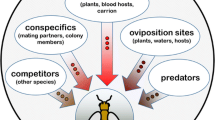Abstract
Insects rely significantly on olfactory cues for recognition and finding of vital resources such as food and mates. Odor detection is mediated by primary sensory neurons housed in individualized cuticular structures, the sensilla. Using microelectrode-based techniques, it is possible to record the nervous activity inside specific sensilla after odor stimulation. We describe in this chapter the methods routinely used in our laboratory to stimulate, record, and analyze the activity of olfactory receptor neurons in moths or flies.
Access this chapter
Tax calculation will be finalised at checkout
Purchases are for personal use only
Similar content being viewed by others
References
Steinbrecht RA (1996) Structure and function of insect olfactory sensilla. Ciba Found Symp 200:158–177
Kaissling KE (1974) Sensory transduction in insect olfactory receptors. In: Jaenicke L (ed) Biochemistry of sensory functions. Springer, Berlin
Kaissling KE, Thorson J (1980) Insect olfactory sensilla: structural, chemical and electrical aspects of the functional organization. In: Satelle DB, Hall LM, Hildebrand JG (eds) Receptors for neurotransmitters, hormones and pheromones in insects. Elsevier-North Holland, Amsterdam
Pezier A, Acquistapace A, Renou M, Rospars JP, Lucas P (2007) Ca2+ stabilizes the membrane potential of moth olfactory receptor neurons at rest and is essential for their fast repolarization. Chemical Senses 32:305–317
Party V, Hanot C, Said I, Rochat D, Renou M (2009) Plant terpenes affect intensity and temporal parameters of pheromone detection in a moth. Chemical Senses 34:763–774
Marion-Poll F (1995) Object-oriented approach to fast display of electrophysiological data under MS-Windows. J Neurosci Methods 63:591–592
Blejec A (2005) Statistical method for detection of firing rate changes in spontaneously active neurons. Neurocomputing 65–66:557–563
Author information
Authors and Affiliations
Editor information
Editors and Affiliations
Rights and permissions
Copyright information
© 2013 Springer Science+Business Media, LLC
About this protocol
Cite this protocol
Renou, M., Lucas, P. (2013). Functional Characterization of Insect Olfactory Receptor Neurons Through In Vivo Approaches. In: Crasto, C. (eds) Olfactory Receptors. Methods in Molecular Biology, vol 1003. Humana Press, Totowa, NJ. https://doi.org/10.1007/978-1-62703-377-0_13
Download citation
DOI: https://doi.org/10.1007/978-1-62703-377-0_13
Published:
Publisher Name: Humana Press, Totowa, NJ
Print ISBN: 978-1-62703-376-3
Online ISBN: 978-1-62703-377-0
eBook Packages: Springer Protocols




